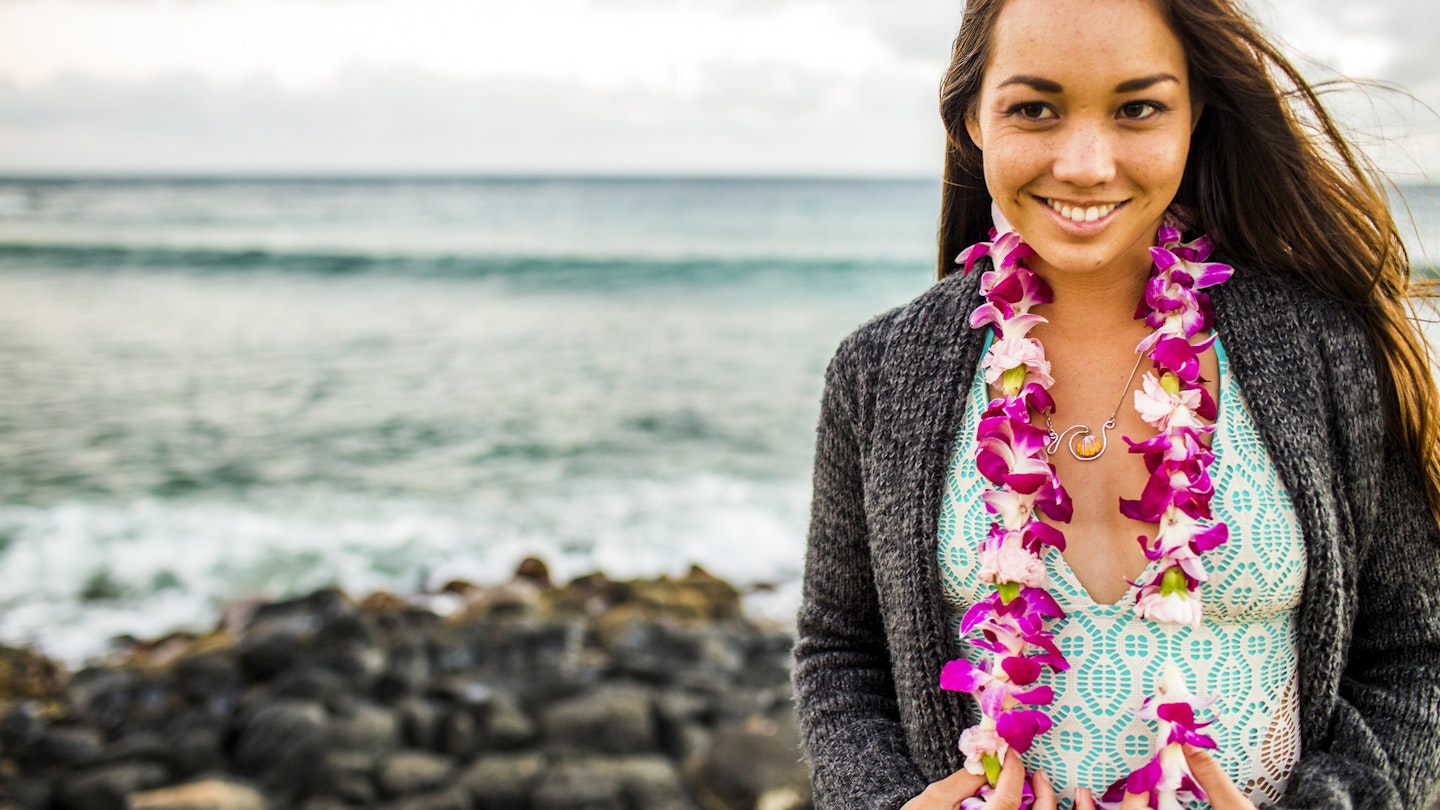The Significance of Lei in Hawaii
You’ll see lei at birthdays, weddings, graduation parties, luau, and even at the airport when you arrive. Defined as a garland or wreath, lei is much more than just a beautiful adornment. In Hawaii, it’s the symbol of aloha, something you give to someone you love, and a way to show appreciation—a warm welcome.
The first time I remember wearing a lei was during my kindergarten graduation. It’s customary in Hawaii to drape lei— as many as possible! — on graduates, even as young as preschoolers.
It’s common to see high school seniors decked in dozens of lei stacked so high on their shoulders that you can hardly see their faces. I wore a fragrant triple-strand white pīkake (jasmine) lei at my wedding and a haku (braided lei for your head) on my 40th birthday—one from my mom, the other from my husband.
Lei is prevalent throughout Hawaii, and most travelers will encounter it as soon as they arrive in the Islands. Many hotels greet their guests with lei immediately in the lobby. There are lei stands at the airport, lei shops in Chinatown, and most supermarkets, including convenience stores, sell lei.
History of Lei
The stringing of flowers into ceremonial garlands has occurred for centuries in Asia. Early Polynesian voyagers who arrived on the Hawaiian Islands from Tahiti as early as the 5th century brought their customs with them.
Over time, Indigenous Hawaiians developed their own unique traditions found nowhere else in the world. In the early days of Hawaii, lei was created as an adornment made mostly from flowers, leaves, ferns, seeds, nuts, shells, and bright feathers for sacred ceremonies, hula performances, and special occasions.
Today, you can find lei made out of candy, ribbon, and origami-folded dollar bills. (Locals don’t wear plastic flower lei.)
Lei’s Popularity with Tourists and Celebrities
During the 1900s, tourism in Hawaii began to grow, and lei greeters lined the pier at Aloha Tower on Oʻahu to welcome visitors disembarking from ships with strands of lei. When visitors left the Islands, some tossed the lei into the ocean as the ship passed Lēʻahi (Diamond Head)—hoping for a swift return.
In 1961, American crooner Elvis Presley famously wore a yellow-and-white plumeria lei to promote the movie Blue Hawaii. He donned a red and pink carnation lei—striking against his jeweled white jumpsuit—in his live broadcast of Aloha from Hawaii in 1973.
US Presidents John F. Kennedy, Bill Clinton, and Barack Obama (who hails from Hawaii) as well as celebrities like Jennifer Aniston, Cameron Diaz, and Bradley Cooper have worn lei during their visits to the state. In 2018, Sigourney Weaver showcased a custom gown by Native Hawaiian designer Manaola Yap at the New York Botanical Garden’s Conservatory Ball, paired with strands of pīkake lei.
Different Kinds of Lei
There are various types of lei based on their construction methods. The kui method is the most common, which strings flowers lengthwise using a needle and thread. The haku starts with a base material, often softened tree bark or long leaves, that is braided.
Lei makers add decorative flowers and foliage without the use of thread. Haku is often worn on the head and shouldn’t be confused with lei poʻo, or flower crowns, which follow a different crafting method.
The most common lei visitors will see on the Islands is the Dendrobium orchid lei. Hawaii typically imports these flowers from Thailand. Lei makers have innovatively transformed these purple flowers into stunning works of art.
The flowers are durable and long-lasting. While they lack a strong fragrance, pīkake or Arabian jasmine has tiny, delicate flowers that are incredibly aromatic; you’ll want to wear more than one strand of this lei because a single strand is thin and fragile.
The trumpet-shaped flower of the pua kenikeni tree (Fagraea berteroana) changes color from white to orange as it ages. Maile, a native twining shrub, is used in an open-ended lei and is worn on very special occasions such as weddings and graduations. The sweet-smelling awaʻawapuhi keʻokeʻo, or white ginger, is another popular flower used in lei among locals; it lies flat with petals facing outward.
Lei Etiquette – What You Should Know
A lei is given and received with love. Therefore, when presented with lei, you shouldn’t reach for it or push it away. The custom is for the recipient to lower their head, allowing the giver to place the lei on your shoulders. If you have a medical reason why you can’t receive a lei, respectfully explain your situation while still showing appreciation for the gesture.
It’s not necessary to hug or kiss the cheek of the giver—though many locals do. You should wear the lei and not remove it immediately; wait until the giver is out of sight to do so.
If you’re pregnant, you may receive an untied lei. By tradition, hāpai (pregnant) or nursing women should not wear a closed lei as it symbolizes the umbilical cord wrapping around the baby’s neck.
Take Lei Home With You
Wishing to bring lei back with you? You can—but it depends on the materials of the lei. It cannot include any citrus or citrus-related flowers, leaves, or other plant parts.
Additionally, gardenia, jade vine, or Mauna Loa are prohibited. Some kukui (candlenut) lei may also be restricted as they often contain citrus or citrus-related leaves. Check the rules on the Hawaii Department of Agriculture website. Ginger, tuberose, maile, and orchid lei are acceptable as long as they pass agricultural inspection at the airport.
If you no longer wish to keep your lei, while tossing it in the nearest garbage can may seem normal, it is disrespectful. Instead, remove anything artificial like strings or ribbons and return the flowers and foliage to nature—in a park, forest, or ocean. Ensure it consists solely of flowers and leaves to avoid littering.




